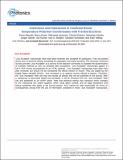Files in this item
Coherence and interaction in confined room-temperature polariton condensates with Frenkel excitons
Item metadata
| dc.contributor.author | Betzold, Simon | |
| dc.contributor.author | Dusel, Marco | |
| dc.contributor.author | Kyriienko, Oleksandr | |
| dc.contributor.author | Dietrich, Christof P. | |
| dc.contributor.author | Klembt, Sebastian | |
| dc.contributor.author | Ohmer, Jürgen | |
| dc.contributor.author | Fischer, Utz | |
| dc.contributor.author | Shelykh, Ivan A. | |
| dc.contributor.author | Schneider, Christian | |
| dc.contributor.author | Höfling, Sven | |
| dc.date.accessioned | 2020-12-17T00:37:04Z | |
| dc.date.available | 2020-12-17T00:37:04Z | |
| dc.date.issued | 2019-12-17 | |
| dc.identifier | 264613043 | |
| dc.identifier | 02cff0c6-d249-442d-95bb-6486e7333192 | |
| dc.identifier | 85078666503 | |
| dc.identifier | 000515214200010 | |
| dc.identifier.citation | Betzold , S , Dusel , M , Kyriienko , O , Dietrich , C P , Klembt , S , Ohmer , J , Fischer , U , Shelykh , I A , Schneider , C & Höfling , S 2019 , ' Coherence and interaction in confined room-temperature polariton condensates with Frenkel excitons ' , ACS Photonics , vol. Just Accepted . https://doi.org/10.1021/acsphotonics.9b01300 | en |
| dc.identifier.issn | 2330-4022 | |
| dc.identifier.other | ArXiv: http://arxiv.org/abs/1906.02509v1 | |
| dc.identifier.uri | https://hdl.handle.net/10023/21170 | |
| dc.description | Funding: The Wuerzburg group acknowledges financial support from the state of Bavaria and the DFG through the Wuerzburg-Dresden Cluster of Excellence on Complexity and Topology in Quantum Matter − ct.qmat (EXC 2147, project-id 39085490). | en |
| dc.description.abstract | Strong light-matter coupling of a photon mode to tightly bound Frenkel excitons in organic materials has emerged as a versatile, room-temperature platform to study nonlinear many-particle physics and bosonic condensation. However, various aspects of the optical response of Frenkel excitons in this regime remained largely unexplored. Here, a hemispheric optical cavity filled with the fluorescent protein mCherry is utilized to address two important questions. First, combining the high quality factor of the microcavity with a well-defined mode structure allows to address whether temporal coherence in such systems can be competitive with their low-temperature counterparts. To this end, a coherence time greater than 150 ps is evidenced via interferometry, which exceeds the polariton lifetime by two orders of magnitude. Second, the narrow linewidth of the device allows to reliably trace the emission energy of the condensate with increasing particle density and thus to establish a fundamental picture which quantitatively explains the core nonlinear processes. It is found that the blueshift of the Frenkel exciton-polaritons is largely dominated by the reduction of the Rabi splitting due to phase space filling effects, which is influenced by the redistribution of polaritons in the system. The highly coherent emission at ambient conditions establishes organics as promising room temperature polariton lasers and the detailed insights on the non-linearity are of great benefit towards implementing nonlinear polaritonic devices, optical switches and lattices based on exciton-polaritons at room temperature. | |
| dc.format.extent | 4783322 | |
| dc.language.iso | eng | |
| dc.relation.ispartof | ACS Photonics | en |
| dc.subject | Polariton condensate | en |
| dc.subject | Organic semiconductor | en |
| dc.subject | Fluorescent protein | en |
| dc.subject | Room-temperatute | en |
| dc.subject | Zero-dimensional | en |
| dc.subject | Microcavity | en |
| dc.subject | Strong coupling | en |
| dc.subject | QC Physics | en |
| dc.subject | QD Chemistry | en |
| dc.subject | TK Electrical engineering. Electronics Nuclear engineering | en |
| dc.subject | T-NDAS | en |
| dc.subject.lcc | QC | en |
| dc.subject.lcc | QD | en |
| dc.subject.lcc | TK | en |
| dc.title | Coherence and interaction in confined room-temperature polariton condensates with Frenkel excitons | en |
| dc.type | Journal article | en |
| dc.contributor.institution | University of St Andrews. School of Physics and Astronomy | en |
| dc.contributor.institution | University of St Andrews. Condensed Matter Physics | en |
| dc.identifier.doi | 10.1021/acsphotonics.9b01300 | |
| dc.description.status | Peer reviewed | en |
| dc.date.embargoedUntil | 2020-12-17 |
This item appears in the following Collection(s)
Items in the St Andrews Research Repository are protected by copyright, with all rights reserved, unless otherwise indicated.

